The city that gets fought over the most is also widely considered to be one of the most beautiful on the planet.
Because Jerusalem plays such a significant part in the history of all three of the world's most prominent monotheistic religions, the city has been the site of persistent conflict throughout the centuries.
It was here that the Jews built the First Temple to house the Ark of the Covenant, it was here that Jesus was crucified and risen from the dead, and it was here that the Prophet Muhammad ascended to heaven to receive the word of God. This is the core of the Holy Land.
Jerusalem is considered to be one of the holiest cities in the world, and a trip there is considered a pilgrimage for Christians. The sheer number of places of worship that serve as tourist attractions in this city can be overwhelming for first-time visitors. However, the majority of the most notable sites and activities for tourists are hidden away within the winding alleys of the tiny Old City region.
Because there is so much to see and do, the best way to tackle a vacation here is to select on a few essential areas of interest and locations to see that are must-dos, and then split your sightseeing down into different sections of the city.
Don't overextend yourself by taking on too much, as this will just tyre you out. To experience everything that Jerusalem has to offer would require a lifetime of visits.
We have compiled a list of the most popular tourist destinations and activities in Jerusalem to assist you in organising your trip around the city.
1. The Temple Mount, also known as Haram al-Sharif
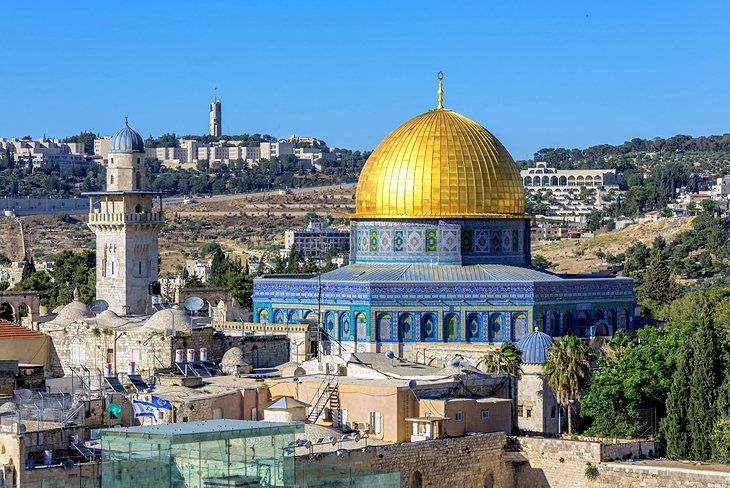
Enter one of the holiest sites on Earth and walk in the footsteps of pilgrims who have come before you over the years.
This is the location where it is said that Abraham, the founder of all three monotheistic religions, offered up his son as a sacrifice to God, where Solomon built the First Temple for the Ark of the Covenant, and where the Prophet Muhammad is said to have ascended to heaven during his early years of preaching Islam. This location is revered by both Jews and Muslims.
For people of faith, the Haram Al-Sharif is a location with profound significance (and a contentious debate regarding ownership).
The sparkling Dome of the Rock, which is Jerusalem's most recognisable monument, is the focal point of the expansive plaza that is located above the old city.
Under the golden dome is a sacred stone that Jews and Muslims believe to be the spot where Abraham gave his son to God, and Muslims also think that this is the spot where the Prophet Muhammad began his ascent to heaven. Both of these beliefs are held by Jews and Muslims.
The Al-Aqsa Mosque may be found on the plaza's southern end, opposite the Western Wall. It is one of the oldest mosques in the world, having been built in 705 CE when it first opened its doors.
2. The Western Wall and the Jewish Quarter in Jerusalem
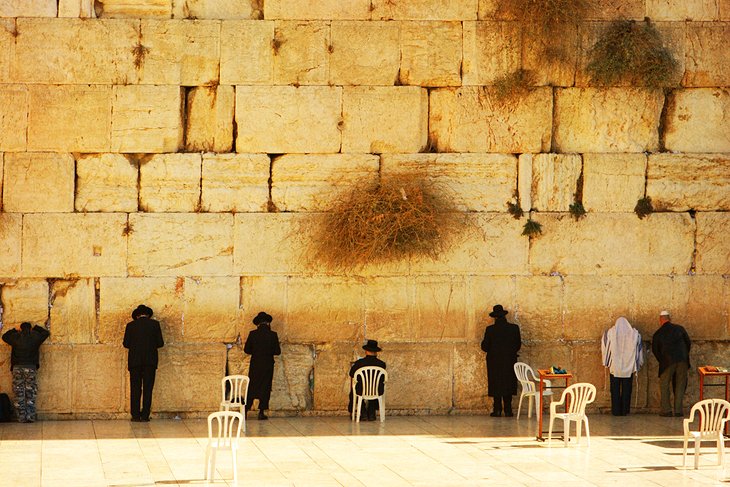
The Western Wall is the only portion of the First Temple's retaining wall that has been preserved.
It is the holiest location in Judaism and has been a place of pilgrimage for the Jewish people since the time of the Ottomans. It is sometimes also known as the Wailing Wall due to the people's laments for the loss of the temple in the year 70 CE.
Within the walls of the old city, the Jewish Quarter can be found roughly between the Zion Gate and the Western Wall Plaza. This section of the Old City was severely damaged during the war between Israelis and Arabs in 1948 and has undergone considerable reconstruction since 1967.
The Jerusalem Archaeological Park, located at the southern end of the Western Wall Plaza, is a must-see for history buffs. Here, archaeologists have uncovered intriguing vestiges of old Jerusalem, and the park is a major attraction for those who are interested in the city's past.
Also not to be missed are the Western Wall Tunnels, which lead down to the level at which the city was originally built and carry you underneath the modern city.
Jewish Quarter Street, also known as Rehov HaYehudim, is the primary thoroughfare of the neighbourhood; however, there is a concentration of fascinating synagogues to explore off of this road and on the side streets that surround it.
3. The Church of the Holy Sepulchre
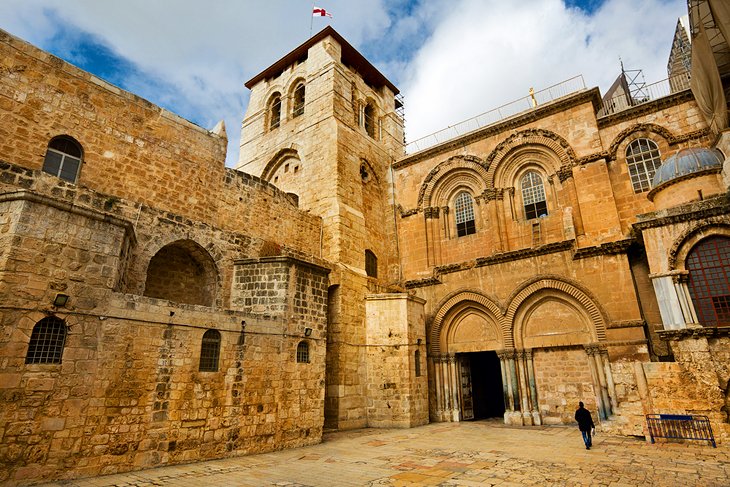
It is believed that the Church of the Holy Sepulchre was constructed on the spot where Jesus was crucified, making it the holiest site in Jerusalem for people who follow the Christian religion.
During her travels to the Holy Land, Constantine the Great's mother, Saint Helena, chose the location for the church that now bears her son's name. She was the one who announced to the rest of the Byzantine world that this location was the biblical Calvary (or Golgotha), where Jesus was crucified.
The first church on the site, which had been constructed in 335 CE, had burned down by the year 1009, and the magnificent church that stands there now was constructed in the 11th century.
The interior of the church is an extravagantly gorgeous piece of ecclesiastical architecture, despite the fact that it is frequently crowded with tourists from all over the world.
This is the final stop on the Via Dolorosa pilgrimage, and the Church of the Holy Sepulchre houses the final five Stations of the Cross within its walls.
The interior of the church is home to a number of sacred relics, and certain sections of the building are administered by various branches of Christianity.
4. Armenian Quarter
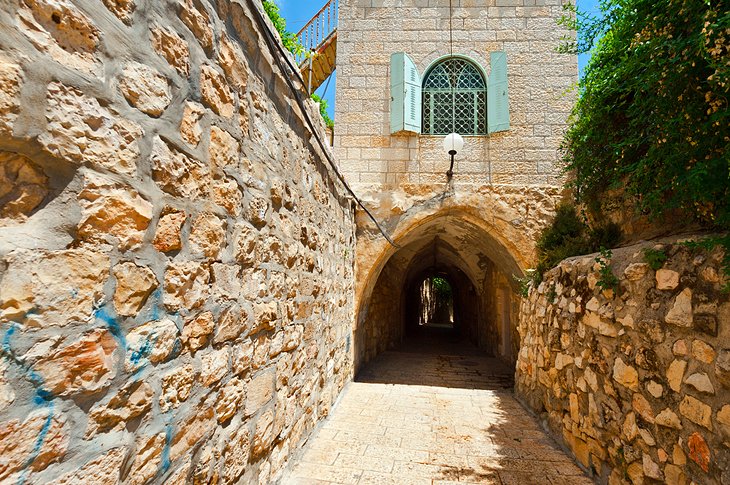
Armenian Patriarchate Road is the primary thoroughfare in the area that is commonly referred to as the Armenian Quarter of the Old City. This road runs south from the Citadel.
The Armenian Orthodox Cathedral of St. James and the Syriac Orthodox St. Mark's Chapel are also located within these winding passageways of the Old City, but they see a far less number of visitors than the other sites in the Old City.
The first Armenians to settle in Jerusalem did so in the fifth century, and since then, they have formed an integral part of the city's community. During the time of the Ottoman Empire and following the genocide of Armenians in Turkey at the turn of the 20th century, many more Armenians immigrated to the United States.
If the crowds of tourists in the Old City of Jerusalem become too much for you to handle, the Armenian Quarter is the most peaceful area to stroll around in and is a fantastic location to go.
5. Continue down the path of the painful Via Dolorosa.

The Via Dolorosa, also known as the Way of Sorrow, is considered by many Christians to be the most important site to see during a trip to Jerusalem.
This walk retraces the steps that Jesus Christ took after he was found guilty and began carrying his cross towards Calvary in preparation for his execution.
The walk can be done on your own time with no difficulty, but if you are in the area on a Friday, you can participate in a procession that will be led by Italian Franciscan monks along this route.
The fourteen Stations of the Cross are located along the route of the Via Dolorosa. Some of these stations are based on the events found in the Gospels, while others are based on tradition.
From the first station on Via Dolorosa Street, which is located to the east of the street's intersection with Al-Wad Street, the walk starts by continuing west along Via Dolorosa Street. After that, head south down Al-Wad Street and then west onto Via Dolorosa Street once more. After going through eight stations, you will arrive at the ninth station at the Church of the Holy Sepulchre, which is where the remaining five stations are located.
Earlier processional ways that Christian pilgrims to the city had utilised before to around the 8th century have been replaced with the current route, which extends for approximately 600 metres and has been the recognised track since the 18th century.
The Chapel of the Flagellation, which is located at the second point along the trip, is an especially interesting stop because it was constructed on the spot where it is believed that Jesus was flogged.
6. Wander Around the Citadel (also Known as the Tower of David) and Its Surroundings
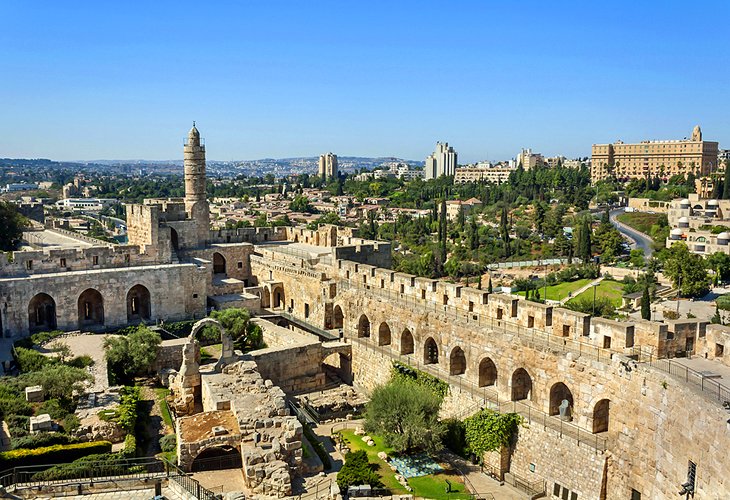
Although it is commonly referred to as the Tower of David, the Citadel was actually built by King Herod to serve as a defence for the palace that he constructed in 24 BCE. David had nothing to do with the construction of the palace.
His first citadel consisted of three towers: one was named after his brother Phasael, another after his wife Mariamne, and the third after his companion Hippicus.
The Romans established a garrison in the citadel following Titus's conquest of the city in the year 70 CE; but, over time, the fortress fell into disrepair and was abandoned. During their respective periods of rule over Jerusalem, the Crusaders, the Mamluks of Egypt, and the Ottomans were each responsible for its subsequent reconstruction.
The ancient Phasael Tower served as the foundation for the edifice that you can see today, which was constructed in the 14th century.
The Tower of David Museum, which tells the history of Jerusalem, may be found on the inside. Visitors have the opportunity to observe both a permanent display of archaeological exhibits as well as temporary exhibitions that investigate various aspects of Jerusalem's culture and legacy.
You will be rewarded with one of the most breathtaking views of the Old City in all of town if you make the ascent to the rooftop of the citadel.
There is a Sound and Light show that takes place here in the evening, and it has graphics that are projected into the city walls. This event is ideal for vacationing families who wish to educate their children about the history of the city, as it takes place in the evening.
7. Religious Buildings in the Christian Quarter
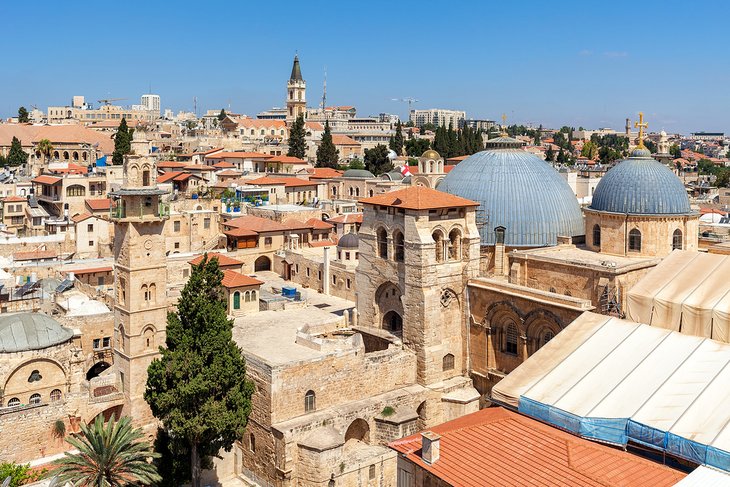
There are churches located all throughout the Old City of Jerusalem; nevertheless, the region extending north from Jaffa Gate and centred around the Church of the Holy Sepulchre is recognised as the Christian Quarter on most tourist maps of the Old City. There are churches located throughout the Old City.
This maze of passageways is home to a number of the Old City's most well-known souvenir souks as well as a large number of churches that are all well worth investigating.
You can rest your weary old city-plodding feet at the nice café at the Protestant Christ Church, which is located in Omar ibn al-Khattab Square. The museum there is unique and features interesting document exhibits.
Interesting frescoes depicting the visit of the Queen of Sheba to Jerusalem may be seen at the Ethiopian Monastery, which is tucked away in a nook and cranny of the courtyard of The Church of the Holy Sepulchre.
Climbing the bell tower at the Lutheran Church of the Redeemer on Muristan Road enables visitors to take in breathtaking panoramas of the Old City. In addition, the Church of St. John the Baptist, which can be found just off of Christian Quarter Street, is Jerusalem's oldest church and is well worth a visit.
8. Muslim Quarter
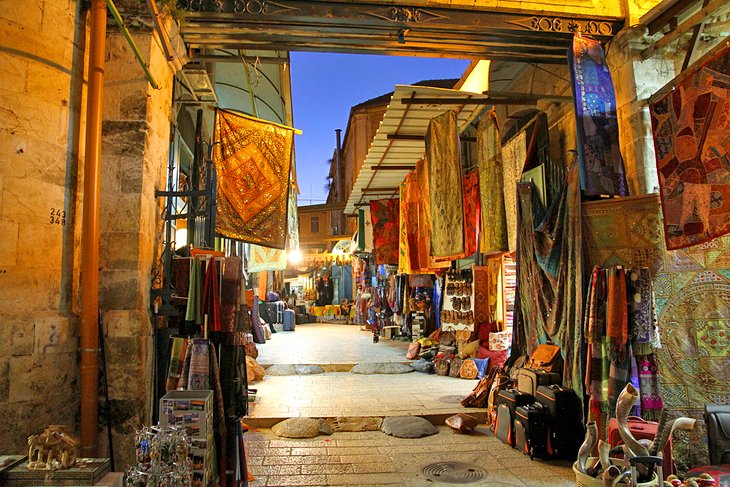
On most tourist maps, the Muslim Quarter is labelled as being the section that is the most active and busy, as well as having the best souk shopping in the Old City.
This neighbourhood can be found roughly from Damascus Gate all the way through the northeastern portion of the Old City.
The streets here are lined with plenty of great surviving vestiges of Mamluk architecture, such as the 14th-century Khan al-Sultan (Bab al-Silsila Street), where you can climb up to the roof for excellent views across the higgledy-piggledy lanes. There are also plenty of other examples of Mamluk architecture lining the streets here.
St. Anne's Church, which is believed to have been constructed on top of the location of the house where the Virgin Mary's parents lived, and the Pool of Bethesda may be found right next door to one another if you take a stroll down Antonia Street. Both of these sites were constructed by crusaders.
9. Mount of Olives, Jerusalem
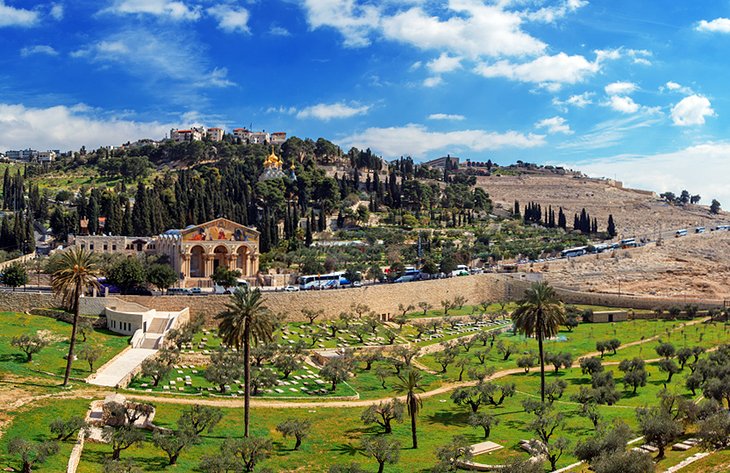
The Mount of Olives, which is laden with churches and is home to the oldest cemetery in the world that is still in use, is of particular importance to religious pilgrims who are visiting Jerusalem. However, even those who are not religious can appreciate the breathtaking views of the Old City that can be seen from the pinnacle of the mountain.
On the day of judgement, it is thought that God will begin raising the dead starting on this holy hill. According to the teachings of Christians, this is the location from where Jesus ascended to heaven following his crucifixion and subsequent resurrection from the dead.
The Church of the Ascension, which sits atop the peak and dates back to 1910, offers some of the most breathtaking views of Jerusalem and the surrounding area.
As you make your way down the slope, you will eventually reach the Church of the Pater Noster, which was constructed just adjacent to the spot where tradition has it that Jesus taught his disciples.
The onion-domed Russian Church of Mary Magdalene is located further along, while the Church of Dominus Flevit is said to have been erected over the spot where Jesus wept for Jerusalem. The Church of Dominus Flevit is located further down.
The following stops on the Mount of Olives are the Church of All Nations and the Gardens of Gethsemane, where Jesus was taken into custody. The Tomb of the Virgin Mary is the final major site on the Mount of Olives.
10. The Mountain of Zion
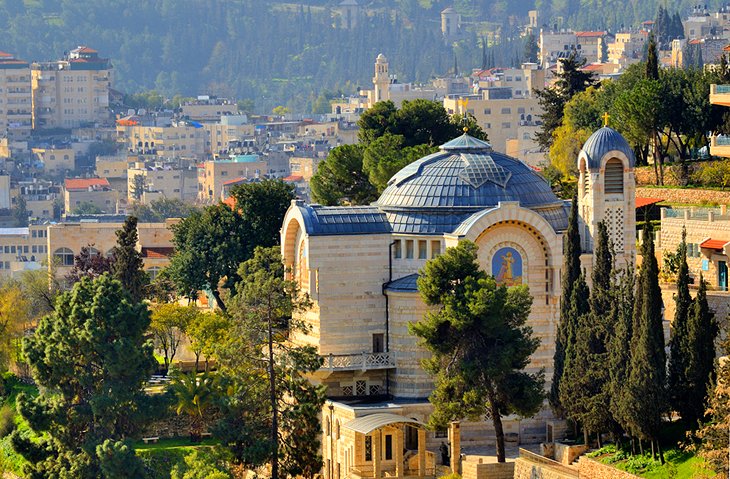
A number of Christian churches, in addition to Jewish and Muslim holy sites, may be found atop Mount Zion, which is a tiny hill located immediately to the south of the Zion Gate in the Old City.
Mount Zion has been cherished as the location where Jesus Christ had the Last Supper and where the Virgin Mary is said to have spent the last years of her life, according to certain Christian traditions (although another version claims that she spent her final days in Ephesus, which is located in Turkey). This veneration dates back to the Byzantine Age.
The fact that the tomb of King David is located on Mount Zion is the primary reason for the mountain's significance to Jews. After ascending the stairs from the tomb's courtyard, you will reach the Last Supper Room, which during the course of the building's extensive history has functioned as both a church and a mosque.
The neighbouring Church of the Dormition is the location where it is believed that the Virgin Mary passed away. Just a short distance to the east is the Church of St. Peter of Gallicantu, which is the location where it is believed that Peter denied knowing Jesus.
11. Take a stroll along the historic city walls.
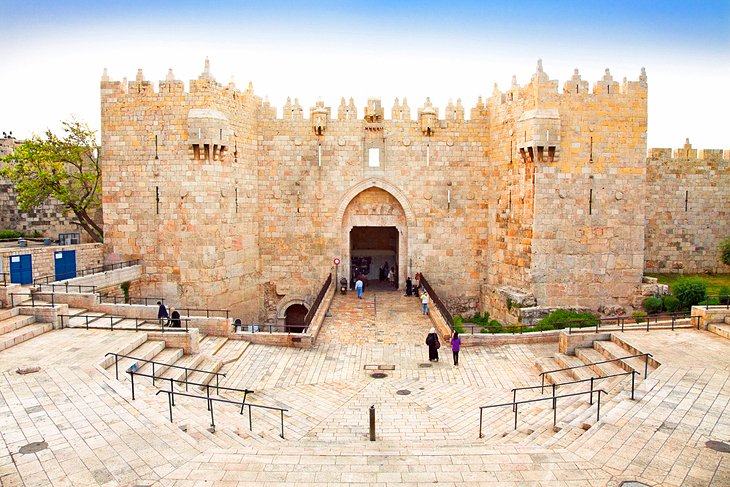
The walls of the Old City date back to the time of the Ottomans, and there are nine magnificent gates located at junctions along the length of the wall that entrance into the Old City.
One of the most well-known entrances is called the Damascus Gate. Lion's Gate, which is also known as St. Stephen's Gate, is located outside the city walls and provides access to the Mount of Olives. Zion Gate is the most important route leading into the Jewish Quarter, whereas Jaffa Gate is the most important tunnel leading into the Christian Quarter.
Walking up the ramparts of the city walls is a fantastic opportunity to get a feel for the Old City. You have the option of walking from Jaffa Gate in the direction of Lion's Gate or Jaffa Gate in the direction of Dung Gate. Both of these routes are accessible by foot.
12. East Jerusalem
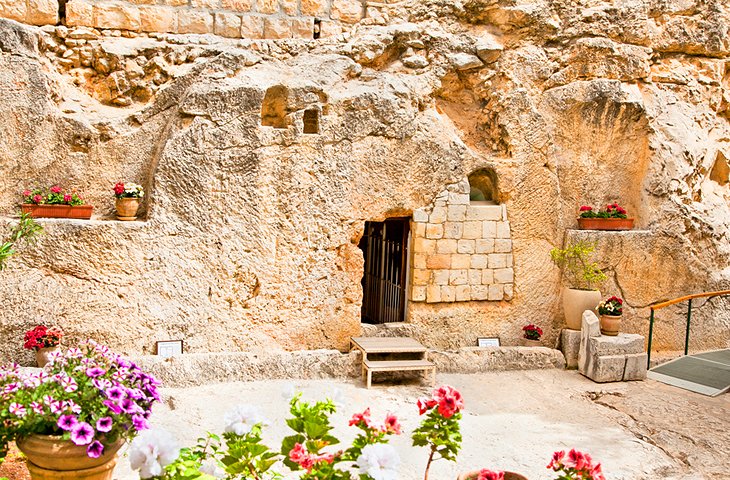
Officially, the entire ancient city is considered to be a part of East Jerusalem, which is the name given to the Palestinian area of Jerusalem that is currently occupied by Israel. Damascus Gate is the most prominent gateway leading into the "newer" sector of East Jerusalem, which is located beyond the old city walls.
The Solomon's Quarries are a cave system that stretches under the Old City and may be found just to the east of the gate among the gardens that are located at the base of the wall. There is a long-held belief that the stone that was used to construct the First Temple in Jerusalem came from this area.
In Jewish legend, Zedekiah, the last king of Judah, sheltered here from the Babylonian invaders in the year 587 BCE. Because of this, the cave is also known as Zedekiah's Grotto.
The Rockefeller Archaeological Museum can be found just a little bit to the east of where you are, along Sultan Suleiman Street. On display within are artefacts dating from as far back as the Stone Age and going all the way up to the 18th century.
Among the main activities of my recent trips to Israel and Italy were visits to important religious sites and places of worship in Jerusalem, Haifa and Vatican City, with the aim of communicating to the public and to religious and political leaders that, from thousands of years… pic.twitter.com/bcbeZQroqc
— Reza Pahlavi (@PahlaviReza) April 28, 2023
If you are limited on time, some of the highlights of the collection include the skeleton discovered on Mount Carmel, also known as the Carmel Man, which is housed in the South Gallery; the Lachish letters, which date back to the sixth century BCE, are housed in the North Gallery; and the ornately carved beams from the Al-Aqsa Mosque are housed in the South Room. All of these exhibits are located in the South Room.
If you take a stroll down Nablus Road, you will eventually arrive to the Garden Tomb, which was constructed during the Byzantine or Roman periods. General Gordon discovered it in 1882 and positively recognised it as the tomb of Christ. To this day, some Protestant Christians continue to hold the belief that this is the actual location where Christ was laid to rest and from whence he arose again.
It is thought that the French Dominican Monastery of St. Stephen, whose namesake was the first Christian martyr, was the location where he was stoned to death. The monastery is located to the north of Nablus Road.
From this location, take a left turn onto St. George Street and continue straight until you reach the Mandelbaum Gate. It was the only crossing point between the Israeli sector and the Jordanian sector of Jerusalem during the years of 1948 and 1967. A plaque has been placed there to mark the location.
The Museum on the Seam is a contemporary art museum that is also located on St. George Street. The pieces that are displayed there deal with social commentary on topics such as human rights and war.
13. Locations in the Central City of West Jerusalem
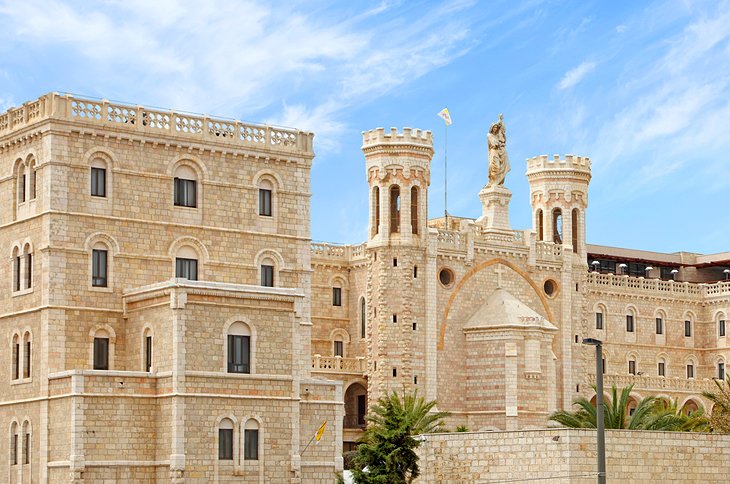
Through the Jaffa Gate in the Old City, you can reach the modern core city neighbourhood of West Jerusalem, which is bounded by Jaffa Road, which runs in a northwesterly direction to Bar Kochba Square and Zion Square.
When travelling northeast from Bar Kochba Square, you will arrive at the Russian Compound, which is dominated by the Russian Orthodox Cathedral with its green dome. In the latter part of the 19th century, this region developed into a sizable walled complex that was used by Russian pilgrims.
The Russian consulate and a hospice for women were located on the northeast side of the complex. A hospital, the mission home, and a huge hospice for men that is located beyond the cathedral were located on the southwest side of the complex. The buildings are now used by a variety of government institutions who have taken up residence there.
You can access the Ethiopian Church via Ethiopia Street, which is located to the north of here. The reliefs of lions that are located above the entranceway are reminiscent of the style of the Lion of Judah that was carried by the Abyssinian dynasty. This style can be traced back to the Queen of Sheba.
Mea Shearim is located further to the north of Ethiopia Street and is home to a population of Jews who adhere to very strict religious traditions. Be advised that in order to access this region, you are required to wear modest clothing (covering your arms and legs), and you are not permitted to take photographs of the locals here in any circumstance.
The residents of Mea Shearim continue to dress in the traditional garb of eastern Europe and talk primarily in Yiddish. Certain fundamentalist Jewish communities consider themselves to be a ghetto of authentic orthodoxy within the borders of the state of Israel because they do not acknowledge the Jewish state on the grounds that it was not founded by the Messiah.
A child-friendly introduction to Jerusalem's history may be found at the Time Elevator on Hillel Street, which is located south of Jaffa Road. The Museum of Italian Jewish Art & Synagogue also lies to the south of Jaffa Road and features an enormous collection of Judaica.
Ben Yehuda Street is Jerusalem's most popular destination for dining out and going shopping, and it is located on Jaffa Road, which runs west from Zion Square.
14. Israel Museum
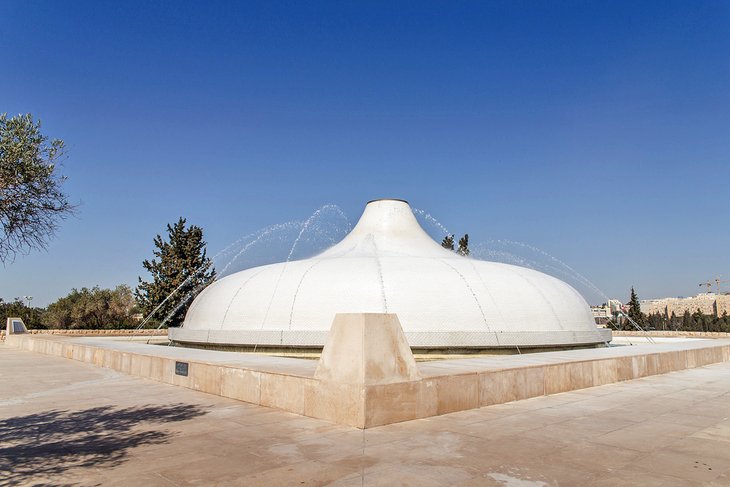
This complex of museums, which first opened its doors in 1965, is the only location in the country that gathers and exhibits both archaeological finds and works of art.
The Dead Sea Scrolls were discovered in the region around the Dead Sea during the 1940s, and the building that houses the Shrine of the Book exhibits the portion of the scrolls that belongs to Israel (the remaining scrolls are on show at Amman's Jordan Museum in Jordan).
An outstanding collection of sacred Jewish art and ethnographic artefacts documenting Jewish life in a variety of countries are on show in the Judaica wing of the main building of the complex.
The archaeological wing of the museum features some of the most interesting artefacts found at archaeological sites across the country, dating from the Neolithic period all the way up to the Ottoman era.
Additionally, there are galleries located nearby that showcase the artwork and artefacts of neighbouring cultures that have had an impact on the history and culture of this region. The galleries present artefacts from Mesopotamia, ancient Egypt, ancient Greece, and ancient Rome, as well as the Arabian Peninsula.
The art section of the museum houses an impressive collection of works by Israeli painters in addition to pieces by Gauguin, Renoir, Van Gogh, and a variety of other works by artists from around the world. In addition to it, there is an ongoing schedule of contemporary art shows.
15. Kidron Valley
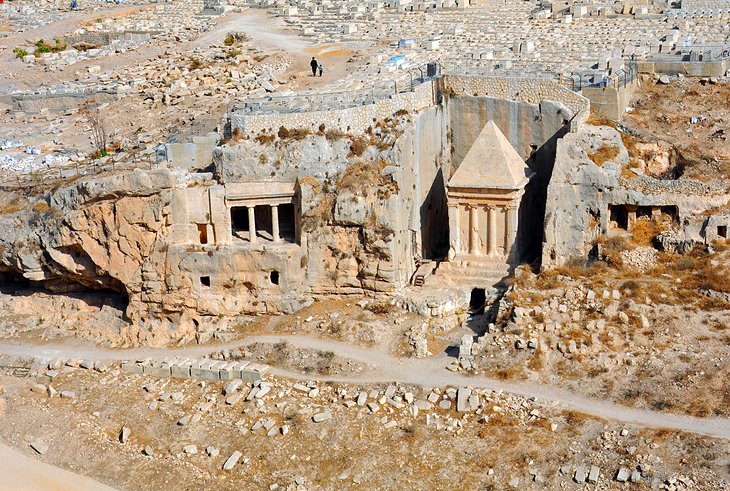
One of the earliest settlements in Jerusalem may be found in the Kidron Valley, which can be found between the Mount of Olives and Mount Zion.
A rope will stretch from the battlements of the Temple Mount, over the valley, to the Mount of Olives, and the righteous will pass over, assisted by their guardian angels, while the sinners will be hurled down into damnation. This is a belief that is shared by both Jews and Muslims.
The ruins of a settlement dating back more than 4,000 years have been discovered here by archaeologists doing excavations. The archaeological site is commonly referred to as the City of David, and there is presently active excavation taking on here.
The construction of Area G began in the 10th century BCE, making it the oldest section of the site. You can walk down into the tunnels known as Warren's Shaft and Hezekiah's Tunnel from here, and then continue on to the Pool of Siloam and Shiloach Pool. Some people believe that this may have been the location where Jesus performed the miracle of curing a blind man.
16. The Church of the Holy Cross Monastery
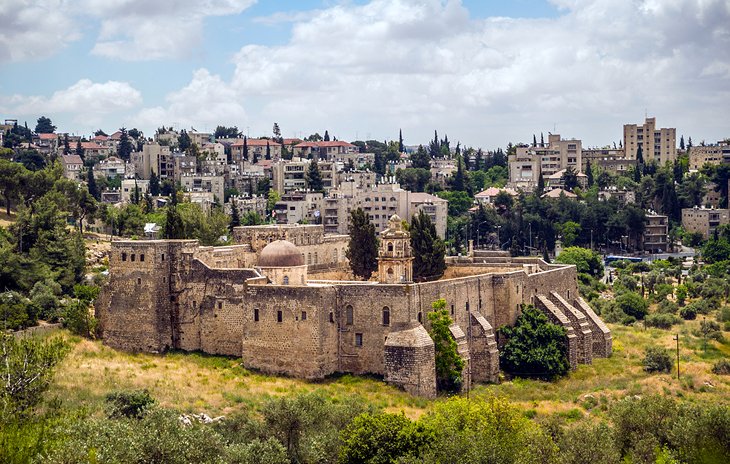
The vast, fortress-like bulk of the mediaeval Monastery of the Cross is said to have been erected on the location where the prophet Lot once resided, according to a local legend.
It is thought that the wood for Christ's cross came from the trees that he planted in the neighbourhood and neighbouring areas. The Empress Helena is credited in Greek Orthodox tradition with establishing the first church at this location.
The church was under the supervision of Georgian monks until the 18th century, when it was retaken by the Greek Orthodox community in Jerusalem.
The monastery was located far to the west of Jerusalem until just a few decades ago, but due to Jerusalem's continued growth, it is now completely surrounded by the city.
17. Yad Vashem, also known as the "Hill of Remembrance"
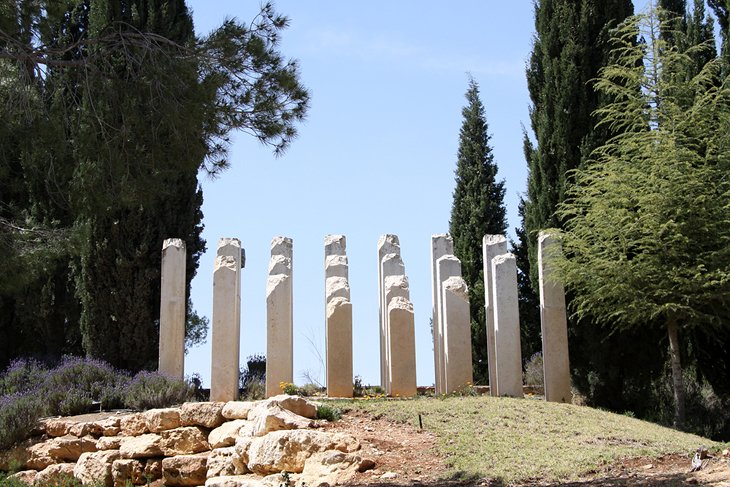
Yad Veshem is the most important memorial to the Holocaust in Israel.
In the primary structure's Hall of Remembrance, the names of Nazi death camps are etched into the floor, and an eternal flame burns in the room as a memorial to those who have passed away there.
A room with the names of victims, a photographic exhibition, a particularly touching children's monument, and an art museum with work produced by inmates from the concentration camps can be found in a room that can be accessed from the main hall.
The expansive grounds that surround the building are home to a number of memorials and pieces of sculpture.
18. Herzl Museum
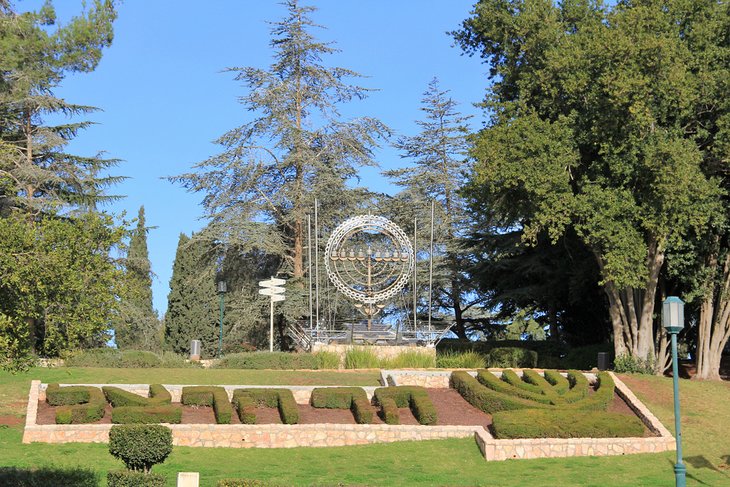
There is a memorial to the founder of Zionism atop Mount Herzl.
The remains of Theodor Herzl, who passed away in Austria in 1904, were moved to Israel in 1949, one year after the establishment of the independent Jewish state for which he supported, and buried in a free-standing sarcophagus on the summit of this hill, which was then named after him. This hill is now known as Herzl Hill in his honour.
The Herzl Museum can be found close to the main entrance and features a recreated version of Herzl's study as well as his library.
In addition, the graves of Herzl's parents and several other prominent Zionists may be found within the expansive park.
19. Spend the Day in Jerusalem and Visit Ein Kerem and Abu Ghosh
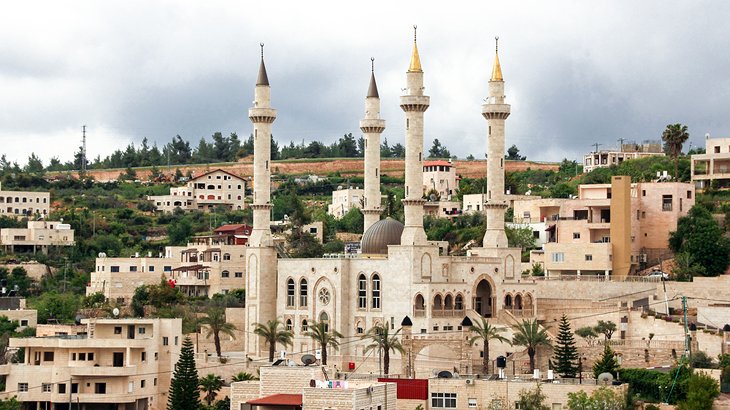
The Ein Kerem Road in Jerusalem leads down into the Ein Kerem Valley, which is where, according to the traditions of the Christian faith, the village of Ein Kerem was the location where John the Baptist was born.
In this location, the Franciscan Friary of St. John was constructed in the 17th century over what is believed to be the birthplace of Saint John, the Grotto of Saint John.
The Church of the Visitation, which is decorated with stunning frescoes, can be found in the middle of the town.
The settlement of Abu Ghosh is located further to the west of the city. This Crusader church, which has been in the possession of the Lazarists since 1956, predominates the landscape of this Palestinian town. The three-aisled cathedral has walls that are four metres thick, giving it the appearance of a fortress, and it exudes a strong sense of crusader character.
In addition, the town of Abu Ghosh is home to the Church of Our Lady of the Ark of the Covenant. Some people believe that this church was built on the location where the Ark of the Covenant was stored before it was moved to King Solomon's temple.
20. Visit Latrun
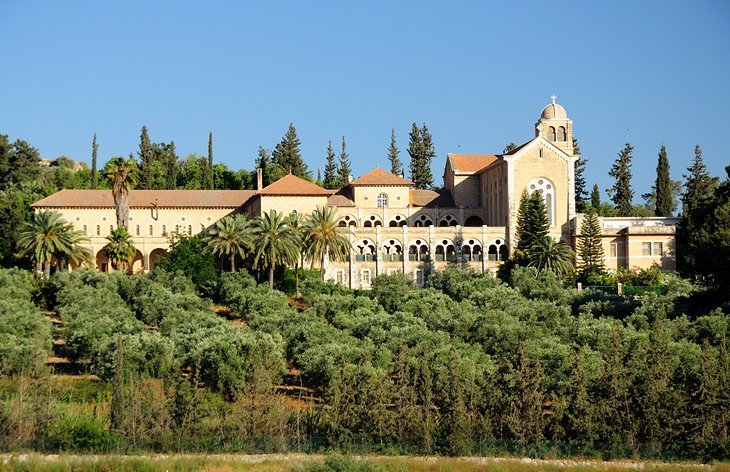
The French Trappist monks established the Latrun Monastery in 1927. It is located approximately 28 kilometres west of Jerusalem.
Up until fairly recent times, Latrun was considered to be of significant importance strategically. The British authorities established a fortified police post at this location during the time of the British Mandate, and it remained there until 1967, standing on the armistice line between Jordan and Israel.
The monks who reside there are members of the Order of Cistercians of the Strict Observance, which is known for its adherence to the monastic rule of silence. The spacious grounds that encompass the main edifice of the monastery are adorned with a lovely landscape design.
A collection of capitals and reliefs from the late Classical period and the early Christian era can be found in the garden.

